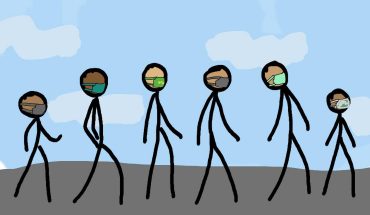BY: JACK HARVEY STAFF WRITER
Without looking at a clock, how close can you get to guessing what time it is? The answer will vary from student to student, but many of you reading this during quarantine will probably be off by more than an hour and a half. Next, try to recall the day of the week and how many days there are between now and next Friday. Did it take surprisingly long?
Answers, I suspect, will largely vary depending on whether you are an essential employee or whether you have spent the past few weeks working from home.
Those precariously situated on the front lines of the pandemic, most famously health professionals, service workers and others who cannot afford not to work, probably remain as aware of the time and date as they’ve always been.
For the rest of us, however, huge chunks of unaccounted time have suddenly been dropped into our schedule. Our days still contain obligations but no longer the feeling of forward motion to which those obligations were once tied. Where once you might’ve had to wake up at a certain time a few hours before a class, eat and find transportation, now all that needs to be done is roll out of bed five minutes before a Zoom session and hope for the best.
Steps once necessary for getting somewhere are no longer necessary, but with their departure something else is lost: structured time to prepare for what lies ahead. Showers, commutes and even bathroom breaks once gave breathing room to examine the overall arc of one’s work for the week and to plan how to fulfill a given obligation.
In a sense, a large chunk of the population has been ripped from what Benedict Anderson called “homogeneous empty time” in his book “Imagined Communities.” This is somewhat of an abuse of the framework of homogeneous empty time, but the basic premise is that the development of the printing press and the birth of a global economy placed people, in terms of thought, at least, on the same timeline across the board. The expression “It’s 5 o’clock somewhere” comes to mind — without ever needing to meet someone from wherever it is 5 o’clock, you know that person might be getting off work at around that time or be surrounded by people who are.
Suddenly, it is 5 o’clock everywhere, all the time. I’ve certainly not been above having a White Russian at 10 a.m. to keep awake after a night of working that started with waking up at 2 a.m. Most of my friends are in similar positions, either dealing with learning how to navigate unstructured time productively or finding ways to ensure their schedules remain as regular as possible.
Perhaps administrators should attempt to realign school and telework with our unstructured days. Rather than holding on to the norms of the 8-hour workday, it would be prudent to use the quarantine to align assignments to the ways people are collectively functioning— which is to say, irregularly.
For those in academia, this means fewer short-term assignments that take about 20 minutes to complete (busywork, even in a non-quarantine setting) and instead more long-form assignments that count for more of your final grade and require students to comprehensively understand the material. It also means making learning expectations clear from the outset to allow students ample time to consider how they will approach studying the material, rather than focusing on a week-by-week instructional schedule where projects are clarified or explained in more detail later in the semester.
For students, the worst thing you can do is fall into a pattern where you’re struggling to sleep regularly, constantly feeling tired, but still feeling like you need to comport to a normal schedule. Try to play around with your sleep and see what makes you feel most productive. For me, it’s been a 4 hours of sleep/8 hours awake schedule that sometimes dips into a whole 16 hours awake if I’m feeling particularly tired. For some, it might be 24 hours awake and 12 sleeping, or the 37-hour Alpha Centaurian time that the Men In Black adhere to. Most importantly, find what makes you feel productive. Can’t keep track of time? Don’t try. It’s homogenous and empty anyway.




